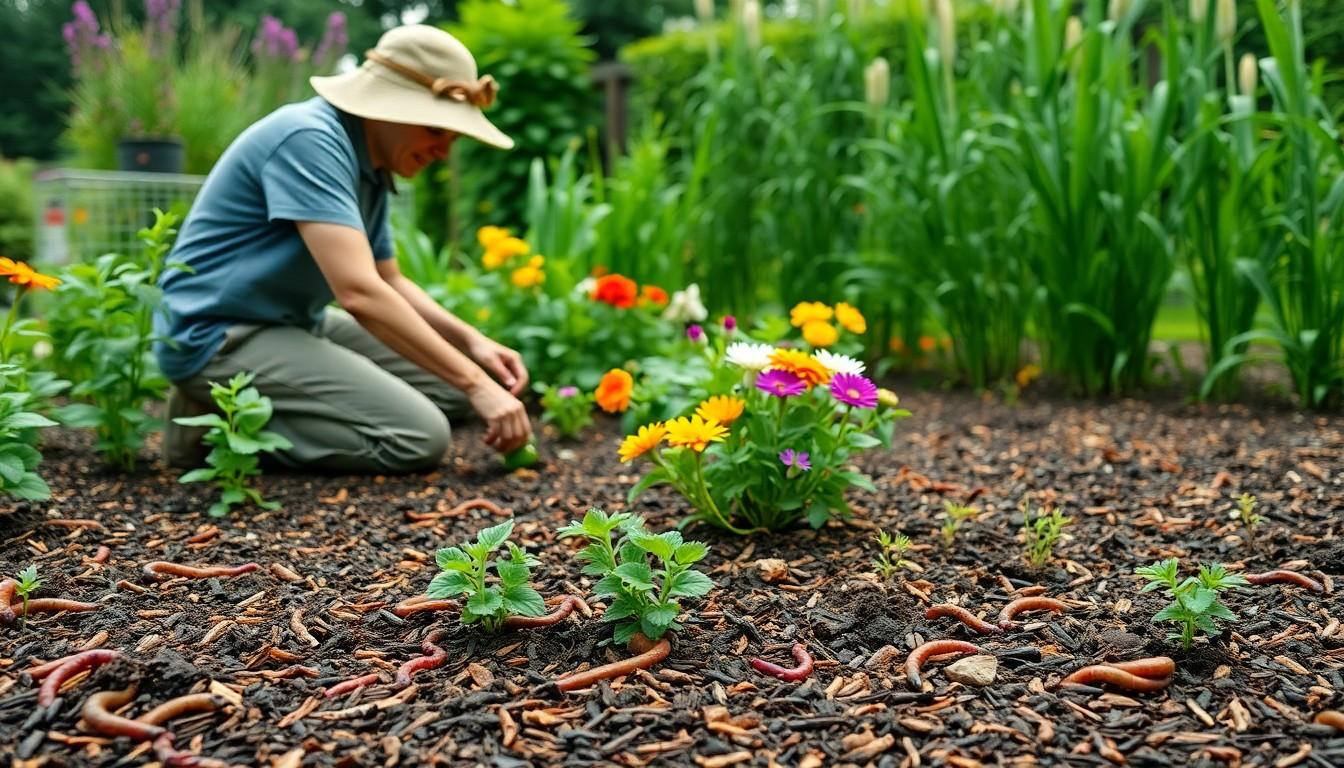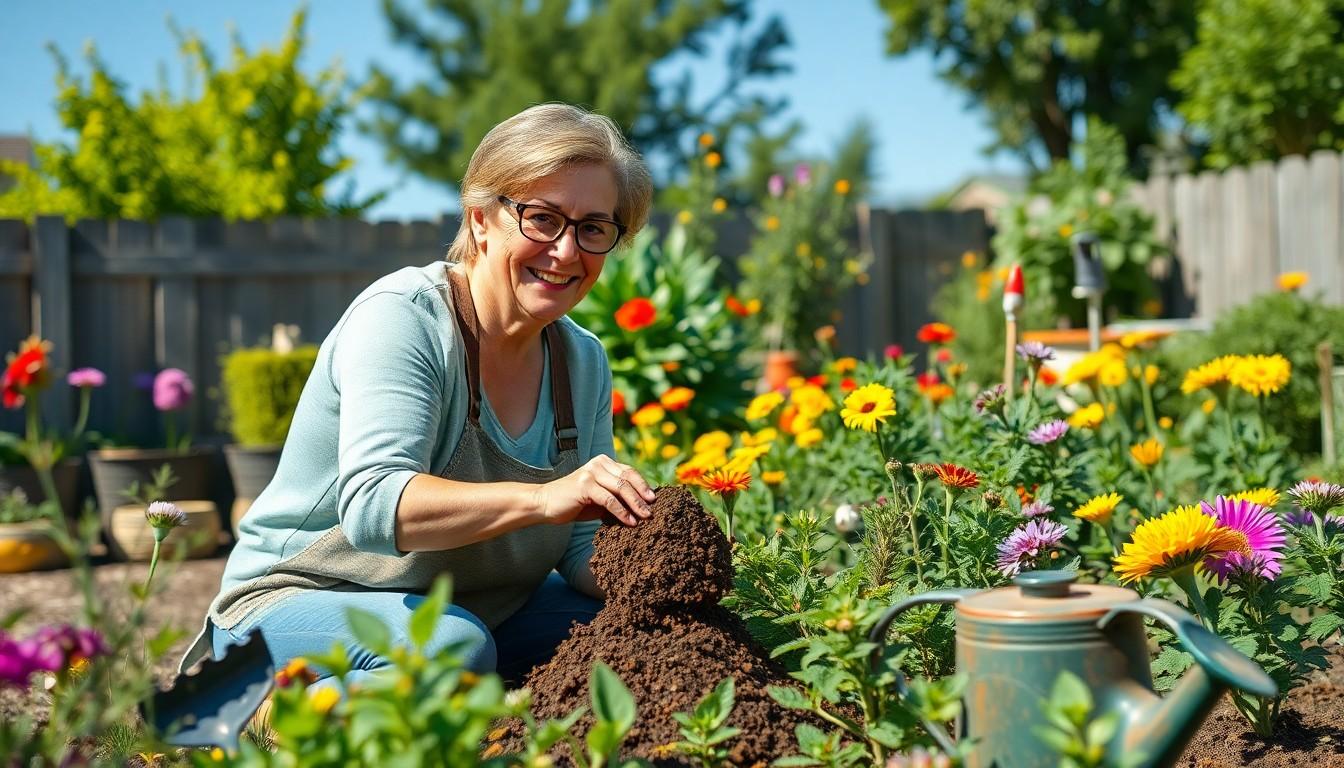Imagine stepping into your backyard and feeling like you’ve just entered a lush paradise, all while knowing you’ve kept Mother Nature smiling. Organic landscaping isn’t just a trend; it’s a lifestyle choice that transforms ordinary yards into vibrant ecosystems. By ditching synthetic chemicals, homeowners can cultivate gardens that are not only beautiful but also safe for kids, pets, and the planet.
organic landscaping
Organic landscaping transforms typical yards into lush ecosystems. This approach prioritizes environmental health by minimizing synthetic chemicals.
Definition and Principles
Organic landscaping focuses on environmentally friendly practices. This method promotes soil health, biodiversity, and the use of natural resources. By incorporating native plants, landscapers create habitats for local wildlife. Methods like composting and mulching enhance soil structure, supporting plant growth. Use of organic fertilizers improves soil fertility without harming the ecosystem. Sustainable water management practices help conserve resources and reduce runoff.
Benefits of Organic Landscaping
Organic landscaping offers numerous advantages for homeowners. Safety stands out as a key benefit, with chemical-free gardens protecting children and pets. Healthier soil leads to more resilient plants, resulting in less maintenance and fewer pests. Biodiversity flourishes in organic landscapes, attracting pollinators and beneficial insects. This method contributes to a cleaner environment by reducing pollution and promoting sustainable practices. Economically, organic landscaping can lower long-term costs through reduced need for chemical treatments and efficient water use.
Key Practices in Organic Landscaping

Organic landscaping relies on sustainable methods that foster a thriving ecosystem while maintaining environmental health. Homeowners engaging in these practices create spaces that are safe and inviting.
Soil Health and Fertility
Enhancing soil health stands at the core of organic landscaping. Organisms like earthworms and beneficial microbes enrich the soil, promoting a balanced ecosystem. Composting organic waste contributes vital nutrients back into the garden, improving fertility. Mulching retains moisture, regulates temperature, and suppresses weeds. Soil tests can identify nutrient deficiencies so adjustments can ensure optimal plant growth. Organic amendments, such as bone meal and kelp, provide essential nutrients without chemical additives. Healthy soil leads to robust plants, fostering resilience against pests and diseases.
Pest and Weed Management
Managing pests and weeds naturally preserves the integrity of the garden. Integrated pest management (IPM) employs a combination of biological controls like ladybugs and cultural practices to keep pests in check. Companion planting offers a strategic way to deter specific insects while promoting biodiversity. Hand-pulling weeds remains an effective method, preventing them from seeding and spreading. Using organic mulch also suppresses weed growth while enhancing soil quality. Regular monitoring of plant health helps identify issues early, allowing for prompt action without harmful chemicals. These natural tactics create a balanced approach to maintaining a healthy landscape.
Designing an Organic Landscape
Designing an organic landscape involves thoughtful planning and a commitment to environmental health. Two essential elements of this process include plant selection and sustainable garden layouts.
Plant Selection and Diversity
Choosing the right plants is crucial for a thriving organic landscape. Select native species to promote local biodiversity and resilience. Native plants adapt to local conditions, require less water, and support local wildlife. Incorporate a variety of plants to create a balanced ecosystem that attracts beneficial insects and birds. Diversity in plant selection not only enhances visual appeal but also improves soil health and pest resistance. Incorporating perennials reduces maintenance while providing year-round color and habitat.
Creating Sustainable Garden Layouts
Sustainable garden layouts contribute to the overall effectiveness of organic landscaping. Prioritize the use of permaculture principles to design functional and efficient spaces. Implement features like rain gardens to manage stormwater and reduce runoff. Arrange plants in guilds to improve resource sharing and natural pest control. Pathways should allow easy access for maintenance while minimizing soil compaction. Utilize vertical gardening techniques to maximize space, especially in smaller yards. Strategically placed trees can provide shade and windbreaks, further supporting an eco-friendly landscape.
Challenges of Organic Landscaping
Organic landscaping presents several challenges that homeowners may encounter. Maintaining a healthy ecosystem requires ongoing effort and attention.
Common Obstacles
Weather variability impacts organic gardens. Drought or excessive rainfall can affect plant growth and soil health. Pest management also poses challenges since organic methods often require more time and patience. Limited availability of organic materials may restrict soil amendments or organic pest control options. Additionally, competition from invasive species can hinder the establishment of native plants, which are essential for biodiversity.
Solutions and Best Practices
Implementing a robust garden design mitigates many challenges. Selecting drought-resistant native plants enhances resilience to fluctuating weather patterns. Utilizing a layered planting method, like guild planting, addresses pest management effectively by fostering beneficial relationships between species. Regular monitoring of soil health promotes nutrient balance. Furthermore, building a network with local suppliers ensures access to organic materials. Engaging in community workshops fosters knowledge about organic practices and problem-solving techniques.
Embracing organic landscaping is more than just a gardening choice; it’s a commitment to fostering a healthier planet. By prioritizing natural methods and native plants, individuals can create beautiful outdoor spaces that thrive without harmful chemicals. The benefits extend beyond aesthetics, promoting biodiversity and enhancing soil health while ensuring safety for families and pets.
Though challenges exist, the rewards of organic landscaping are substantial. With thoughtful planning and sustainable practices, anyone can transform their yard into a vibrant ecosystem. This approach not only beautifies the environment but also contributes to a sustainable future, making it a worthwhile endeavor for any homeowner.

